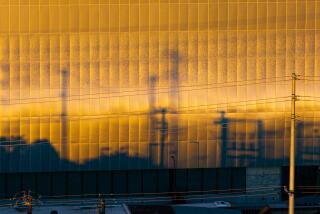Nuclear Scare Put Us on Right Energy Path
- Share via
Ten years ago next Tuesday, a partial meltdown at the Three Mile Island nuclear power plant near Harrisburg, Pa., destroyed a reactor and climaxed the nation’s unhappy experience with nuclear power. Today 108 nuclear plants supply 20% of U.S. electricity, but no more are being built nor are any nuclear plants on order in the United States.
No one was injured directly at Three Mile Island, although lawsuits still argue whether the accident caused long-term illnesses.
But in industry, the accident’s aftermath was beneficial: It forced electric companies to plan more intelligently. Partly as a result, the United States today enjoys the world’s lowest-priced electricity.
And the anniversary is a good time to look ahead as the U.S. electric industry, after years of spare capacity, faces the need to build new power plants.
Electricity usage is growing again. Last summer’s demand surprised electric companies in many regions, and led to power curtailments--or brownouts--in the Northeast. That region’s power shortage is aggravated by the fact that New Hampshire’s Seabrook and Long Island’s Shoreham nuclear plants, which cost billions to build, are not able to operate.
Experts say that new generating capacity will be needed in the Northeast and South as early as 1992. And that could mean a comeback for nuclear power, as worry over global warming--the “greenhouse” effect--casts a shadow over coal-burning power plants.
The Nuclear Regulatory Commission is already planning on a nuclear revival, talking of a standard design of nuclear plant that would be licensed and constructed after being pre-approved by environmental, scientific and regulatory authorities.
Does it make sense to still talk of nuclear energy? Technologically, there’s no reason it can’t be an option. Other nations use U.S. technology for nuclear power. France generates 74% of its electricity with nuclear plants of Westinghouse’s design, and Japan gets 20% of its power from reactors of General Electric’s design.
Both nations employ strong government control, build standard plants and secure pre-approval from their citizens. (Japan, it should be noted, also has a strong program for solar energy).
U.S. industry’s nuclear blunders were managerial, not technical. Poor design and engineering, and sloppy construction work led to massive waste and losses.
Management Erred
There was another blunder, too. The big nuclear plants were out of date even as they were built. Big power plants made sense in the 1950s and ‘60s, when electricity demand was growing 7% a year and added capacity was needed quickly. But in the 1970s, conservation reduced energy usage and adding capacity long in advance of need became uneconomic. Smaller power plants became the way to respond to shifting demand.
And that flexible pattern has continued in the 1980s. Use of gas turbine generators--once reserved only for peak demand--is increasing, reports General Electric Vice President John Urquhart. Gas turbines, costing roughly $20 million apiece, are smaller and easier to finance than giant power plants, allowing utilities a lower-risk way to supply their markets.
Co-generation is supplying more electricity, too, says analyst Edward Tirello Jr. of Shearson Lehman Hutton. Co-generation is an efficient method of producing power in which an electric utility and an industrial company share a turbine’s electrical output, and often sell waste steam to a third industrial user.
Coal is producing electricity in environmentally advanced fluidized bed reactors, in which very high temperatures consume toxic gases inside the furnace.
And finally, the system is learning how to transmit power from regions with surpluses--California and the Pacific Northwest--to regions where power reserves are less abundant.
The watchwords of all those energy solutions, of course, are flexibility and innovation. Should nuclear power be included? Perhaps, in a limited way. The important point of Three Mile Island’s legacy, though, is not that nuclear can work but that many paths lead to a secure energy future.
More to Read
Sign up for Essential California
The most important California stories and recommendations in your inbox every morning.
You may occasionally receive promotional content from the Los Angeles Times.













